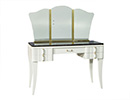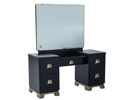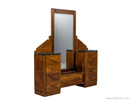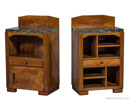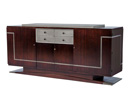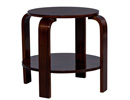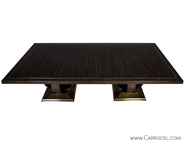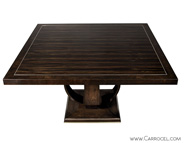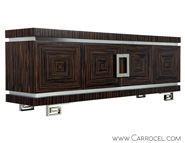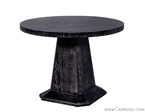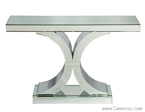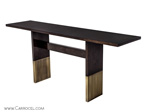Recognizing and Appreciating the Art Deco Style of Furniture
Art Deco Style Furniture: Distinguished Features, Vibrant Wood Finish, and Spirited Designs
It is quite possible than many homeowners have heard and/or read the term Art Deco, used in reference to a certain style of architecture, furniture design, or fashion. It is also highly probable that a majority of these same individuals are unaware of the characteristics of Art Deco design; some might even speculate that this style was inspired by someone named Art Deco, similar to the designer-name clothing and fragrance labels that are being marketed today.
While any such misconception about its origin would indeed be understandable, delving into the history of Art Deco interior design design, particularly in relation to furniture design, reveals a unique era of craftsmanship and style that remains influential to the present day.
The onset of the Art Deco movement is generally linked to the early 20th century and quite often to the Art Deco period immediately after the 1925 International Exposition of Modern Industrial and Decorative Arts in Paris, France. One of the prime influential factors in this movement was the optimism of post-First World War society, an aspect that furniture designers of the era wanted to reflect in their work; as a result, their furniture showed progressive thinking, vibrant colours, and spirited designs.
There are many noteworthy Art Deco Style furniture designers, including the following individuals:
- Paul Mccobb
- Milo Baughman
- Arne Jacobsen
- Jules Leleu
- Paul Evans
- Gio Ponti
- Hans J. Wegner
Some of the materials incorporated into Art Deco furniture by such designers consisted of:
- Exotic wood, and wood finish (teak, macassar ebony)
- Marble (in cabinet/table tops)
- Metals (especially polished metals)
- Plastics, such as Bakelite and Lucite
- Stainless steel, chrome, glass, and ivory
- Furs, animal hides, serpent skins (upholstery)
With respect to the Art Deco style itself, it is recognizable by several distinguishing features:
- Intricate wood inlays
- Symmetrical or angular lines
- Long, smooth, and sweeping curves
- Lavishness – bold colours, patterns, and prints
- Themes e.g.: animals, V-shapes, stars, sunbursts
This Art Deco furniture style continued to grow in popularity throughout the 1920s and into the 1930s; its acceptance began to fade by the outset of the Second World War as the style was considered by many to be too gaudy and extravagant in light of the sombreness of the mid-century modern times. The style experienced a revival/resurgence in the 1960s and vintage Art Deco pieces remain popular and highly sought-after today.
An In-Depth Look at the Art Deco Style and Characteristics
Exotic Woods
Many furniture pieces produced during this period were made using exotic woods like lemonwood, zebrawood, and ebony.
Waterfall Furniture
A key feature that distinguishes waterfall furniture is the rounded drops at the edge of all the horizontal surfaces. These features were developed to imitate a flowing waterfall. This feature was quite popular in the late 1930s and early 1940s.
Lacquer
Art Deco furniture creation involved the application of several lacquer coats to ensure a delicate finish and a smooth sheen. With a lacquer finish, art deco furniture style pieces acquire a timeless look.
Marquetry
Marquetry is the technique of creating geometric bandings and intricate designs using different types of wood. These include satinwood, ivory, ebony, and boxwood. Natural and traditional marquetry patterns are prominent features that feature on art deco furniture pieces.
Leather
During the Art Deco era, furniture designers used rich leather to manufacture club chairs, sofas, and armchairs. These leather pieces were a perfect addition to any stylish den, office, or living room. Club chairs are characterized by rolled arms, tight back designs, and square tapered legs made from leather and handcrafted wood.
How to Recognize Art Deco Furniture
Art deco is characterized by its incorporation of other arts. However, there are no specific motifs that characterize the style as a variety of designs, from linear to floral, are all part of art deco.
When comparing art nouveau to art deco, it is easy to pinpoint the difference. Art nouveau, the movement from the 1880s to 1910s, is distinguished by curved lines that have patterns representing nature. Conversely, art deco, which was popular in the 1920s and 1930s, featured more geometry and straight lines. The sculptures are a bonus since this art showcases the statues of women or other people, inspiring elegance. This type of sculpture is also noticeable on decorations such as vases.
Reproduction Art Deco Furniture
If you treasure the look of art deco furniture style pieces but cannot find antiques that suit your needs, you can look for reproduction art deco furniture pieces. In the late 20th century, several American brands began designing art deco-inspired furniture. You can now find the same soft edges and shapes of period pieces but with a few modern adaptations.
It is without a doubt that beautiful pieces made in the style of art deco or genuine items from the period bring the mystique and glamour of the movement into your home. With modern reproductions, you can enjoy updated fabrics and materials while still experiencing the beauty of the designs.
Stunning Modern Art Deco Furniture for Homeowners, Interior Designers, and Collectors
Homeowners, interior designers, and individual collectors interested in acquiring vintage or custom modern Art Deco furniture would be well-advised to contact/visit the fine furniture experts at Carrocel, centrally located at 245 Bridgeland Avenue near the Yorkdale Mall in Toronto.
The Carrocel fine furniture store offers a stunning collection of Art Deco pieces, including:
- Club Chair
- Dining room tables
- Sideboards and cabinets
- Stainless Steel chairs
- Art Deco Bedroom Armoires, vanities, and wardrobes
- End tables, side tables, night tables
- Dry bars, consoles, occasional tables
A selection of the many exquisite Art Deco pieces currently available from the Carrocel fine furniture store includes the following:
- Art Deco Vanity with Black Marble Top
- Round French Art Deco Tiered Side Table
- French Art Deco Rosewood and Slate Grey Sideboard Circa 1940
- Pair of Asymmetrical Art Deco Night Tables with Marble Tops
- Original Art Deco Vanity with Marble Top
- Black Art Deco Vanity with Mirror
Art Deco Mascassar Furniture:
- Custom Made Art Deco Macassar Ebony Dining Table by Carrocel
- Macassar Ebony Square Walnut Dining Table
- Macassar Greek Key Buffet
Art Deco Consoles:
- French Art Deco Cerused Occasional Table
- Art Deco Style Mirrored Console
- Art Deco Inspired Console Table Made by Carrocel
- Custom Deco Black Lacquered Console Table
For a more complete appreciation of the Art Deco furniture that is currently on display in the Carrocel store, see our Art Deco Furniture page or visit their 20,000 square-foot showroom in Toronto.
Looking for that unique Art Deco piece to enrich the décor of your home, lobby, or business? Call the vintage furniture specialists at Carrocel fine furniture today at 647-250-1446 or Contact us to arrange a no-obligation consultation at your earliest convenience.

